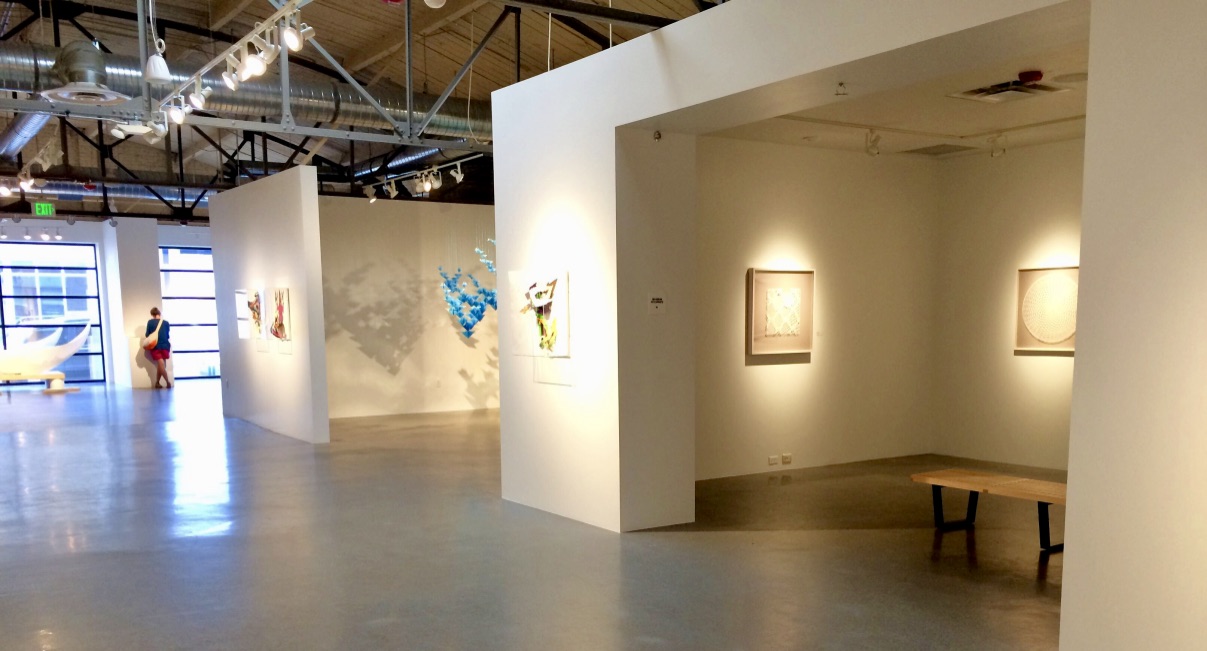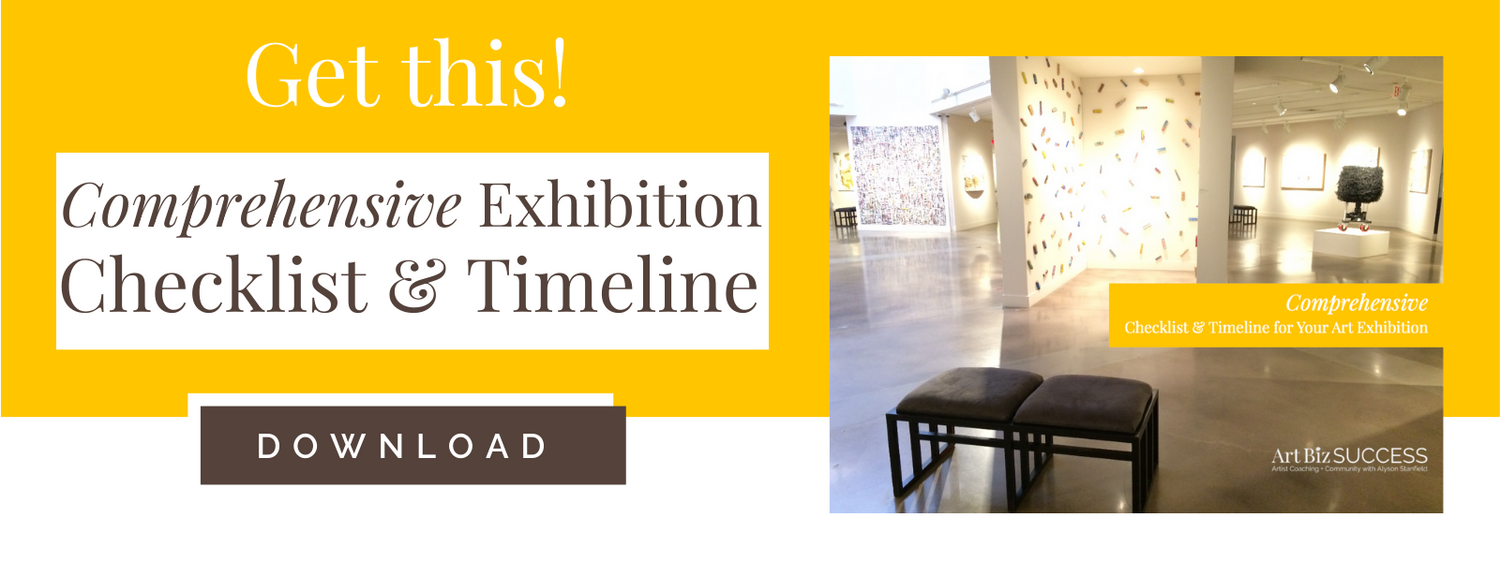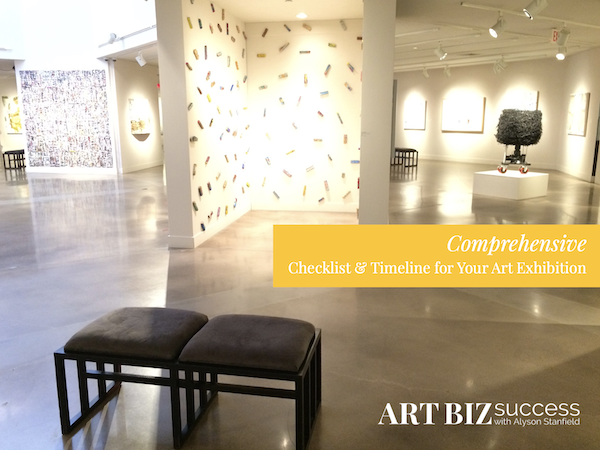Exhibition proposals sound formal and intimidating, but they don't have to be. This outline for writing an exhibition proposal is easy to follow and will help you gain confidence in proposing art shows to a variety of exhibit venues.
What is Your Curatorial Thesis?
When you ask to show your art at a venue, you need to be very clear about what you are offering. People don’t often say Yes to vague offers.
Think about what ties the work together. This is your curatorial thesis – your big idea. Writing it out, as you’ll see below, helps you find the clarity you need.

Before sitting down to write your exhibition proposal, ask the venue if they have a particular exhibition proposal format they prefer. If they do, follow their instructions. If they don’t have specific guidelines, you’ll have to compile an exhibition proposal for yourself.
The details of your proposal will vary depending on whether you’re proposing a show at a coffee shop, a pop-up space, or a nonprofit gallery. You will have to judge what is appropriate for your situation.
Here are major components you’ll include.
Introduce Yourself in a Cover Letter
Personalize your cover letter with the correct name and spelling of the manager, exhibitions director, or curator. It’s much nicer to show you have done your homework than to start off with a generic To Whom It May Concern salutation.
I like to begin cover letters with an acknowledgement that I know something about the recipient. You could compliment them on a recent exhibition or say that you’ve been reading about them. You should also mention anyone you know who is associated with the venue – a patron, board member, or artist.
Thank the recipient for considering your proposal.
Document for Your Exhibition Proposal
The meat of your proposal is a document that outlines the particulars of the exhibition.
- Explain why your art is a good fit with the venue’s exhibition program.
- Describe the exhibition contents and curatorial thesis in 3-4 sentences.
- List the artists, if others are to be included. Insert your résumé or bio, as well as those from any other artists.
- Provide a complete inventory of works to be shown. Include titles, media, and prices.
- Estimate the space required in square or linear feet and any expenses that might be incurred by the venue.
- Suggest a timeline for the show.
Images to Include
Finally, include images of your art in the proposal.
For a small show, include all of the works you plan on showing. For a larger show, you can use a sample of 10-20 images as long as the images are representative of the entire exhibition.
I hope you see how the process of writing an exhibition proposal can be a valuable start to a successful exhibition. And it's just a first step.
Once accepted, you will need a written agreement that outlines the terms between you and the venue and a plan for executing all that you have promised.
This post was originally published on July 28, 2014, and has been updated with original comments intact.




23 thoughts on “What To Include In An Art Exhibition Proposal”
Thanks for this! Writing to a few non-profit galleries is my next “go-get-’em” project to try and increase the quality of my venues, so this is timely and helpful information I will want to go back and refer to later!
You know where to find it when you need it, Michelle.
Perfect timing!
I was just sitting down to write this and here you are.
Thanks for reading my mind!
Love that!
This is great when you’re pitching works you already have, but what about arranging an exhibition in advance before you’ve even painted the whole body of work?
Plenty of artists (some I know, some I follow online) are painting for an “upcoming solo art show”. So how do you get the show before the art? Do you include past work? Does the venue approach you first?
Nela: Either 1) your reputation is stellar and they’ll take whatever you have, or 2) you must show representative work. I can’t imagine a venue booking a show when they had no idea what they were getting. There must be some concept involved. So a concept proposal.
The venue needs to know that you have thought it out and can deliver what you promise.
Yes this is exactly my situation! I already have the gallery and the cutator gave me the time line to do the show. I have no idea what I am suppose to add as images in my proposal because I don’t have anything similar to what I am about to create. I think I am going to literally make rough concept sketches with a color palette board and I will add some old samples of my finished paintings that are obviously not the same theme.
For exhibition proposals, I send copies of my paintings but state that the body of work that will be shown in the exhibition may not contain all of the paintings sent and that other paintings will be added (but they will be in the same style, etc. and represent the same quality as those sent as samples). I do this because while I am waiting for a reply or if the exhibit is more than a month away, those paintings could be put in another exhibition or could be purchased by the time of the proposed exhibit.
Joyce: I imagine you mean “images” of your paintings rather than “copies.”
Has this worked for you?
I imagine that it would be perfectly fine.
Thank you for this helpful post. Estimating the space required in square or linear feet is the part I would tend to leave out because I dislike mathematics. Can’t this be taken care of after the venue lets you know that there is an interest in your proposal?
Linda: No, this is something you need to learn to do because the venue needs to know if they have the space for your work. You could also provide a range to show you’re flexible.
Estimating 2-D work is easy – just double the width!
So, if you have 200 linear inches of work (if placed side by side), you’d need 400″ of wall space or 33 feet.
Thanks for that formula! Makes it easy!
Speaking of non-profit galleries, is it typical for such a gallery to charge “rental” fees for an exhibition? Should you expect to foot the bill for marketing? Just curious, as this is the modus operandi of one of my local venues.
Linda: It is NOT typical for a nonprofit space in the U.S. to charge a rental fee.
Other countries have other models.
You should expect to do a lot of your own marketing, but a nonprofit space should have a budget for, say, postcards to their members and advertising. The important thing with any venue is to realize that YOU are the person who cares about the success of the exhibition. You can’t rely on others to do the marketing as you would like.
Thank you for this article, Alyson. There is a local location, a pretty big garden that also have a gallery that exhibit garden related artworks, that I want to propose. They used to be very casual and the quality of art varies. Only this month, they have their gallery revised, instead of managing it themselves, they have invited a gallery owner to manage their gallery.
When I have 20 or so floral still life paintings, I may very well approach them and pitch for an exhibition. This may be next year. I’ll have to save your article for reference.
I would love to see your work up in a solo show, Lucy. Keep me posted.
Nice one. I just talked with a gallery director in Chicago on a similar subjec — what galleries are looking for in an artist.
Here’s the link.
http://mumora.com/what-galleries-look-for-in-an-artist
Thank you for the wonderful article. My situation is a little different.
I’ve done extensive research on 2 parties:
Art exhibition (Rich owner, 3rd world country)
American artist very popular, tv, radio
Both of these people should make an art exhibit together for mutual benefit, many reasons.
I want connect the two and charge a commission.
1. What would you suggest I do?
2. Who should I approach first?
3. Who do I charge commission to? (I’m thinking the exhibitor?)
4. Would the exhibitor pay for travel, lodging expenses?
thx!
Hello, i am part of a live Art exhibit taking place in February 2015. I wanted some feedback on art pricing. I will be painting as a live artist at the event and will be selling my works. I wanted to know what suggestions you may have on what to charge for my paintings. My works range from 24×33 and up. I wanted help on a price range because i plan to sell my pieces in future solo shows. I appreciate your input and advice. Thank You.
Thanks so much for that amazing information. Can I ask how it works when asking gallery to be considered for a group show? how is the process different?
Many thanks
Shirin: I’m sorry I missed your question earlier.
Most commercial galleries select artists in group shows from the list of artists they already represent. (In truth, group shows are rare in commercial galleries — mostly at the holidays, it seems.) However, this isn’t always the case. I suggest becoming a fixture in the galleries. Make sure you’re seen so they know you’re supportive and that they know you and your work.
Great info!
So glad it’s helpful, DL. Thanks for reading.